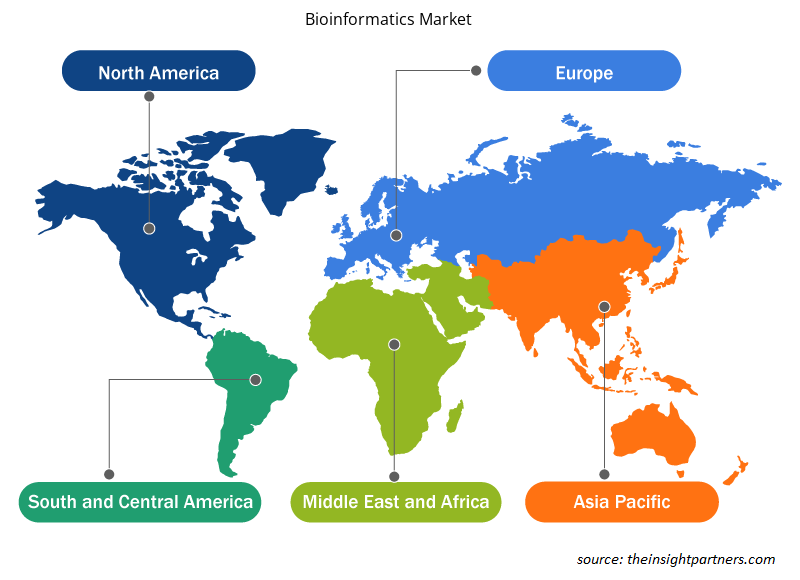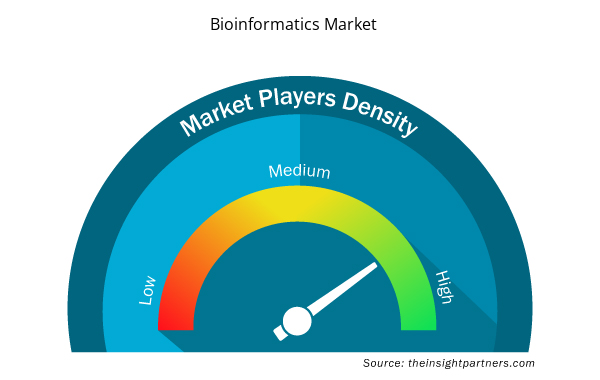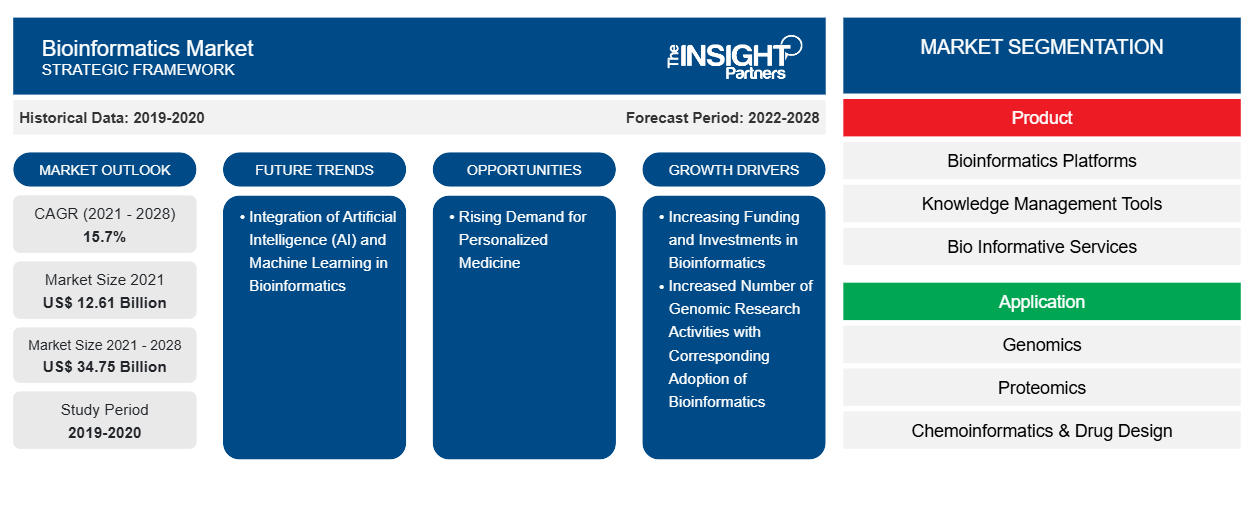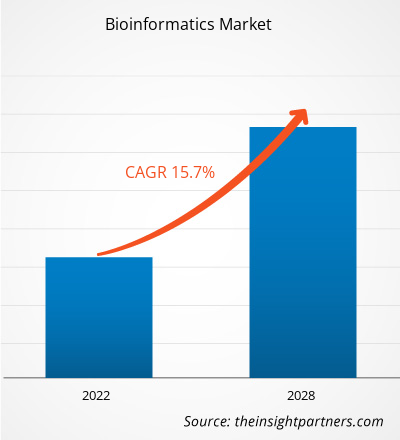[Forschungsbericht] Der Markt für Bioinformatik soll von 12.609,39 Millionen US-Dollar im Jahr 2021 auf 34.749,78 Millionen US-Dollar im Jahr 2028 wachsen; von 2022 bis 2028 wird mit einer durchschnittlichen jährlichen Wachstumsrate von 15,7 % gerechnet.
Markteinblicke und Analystenansichten:
Bioinformatik ist die Anwendung von Informationstechnologie zur Verwaltung biologischer Daten, die bei der Entschlüsselung von Pflanzengenomen helfen. Die Bioinformatik speichert, analysiert und interpretiert die großen Datenmengen, die durch Experimente in den Biowissenschaften generiert oder in einem klinischen Kontext gesammelt werden. Dieses multidisziplinäre Feld wird von Experten mit unterschiedlichem Hintergrund vorangetrieben, darunter Biologen, Informatiker, Mathematiker, Statistiker und Physiker. Die Bioinformatik ermöglicht es Forschern, Experimente in einem Zeitrahmen durchzuführen, der im Leben eines Menschen von Bedeutung ist. Während der Coronavirus-Pandemie konnten Forscher beispielsweise das Genom des Virus sequenzieren, die wahrscheinliche Ursache für das Eindringen des Virus in Zellen identifizieren und innerhalb weniger Monate einen Impfstoff auf der Grundlage des entdeckten Genoms entwickeln. Weitere bioinformatische Ansätze werden verwendet, um andere Krankheiten wie Diabetes und Krebs zu identifizieren und zu behandeln. Das Wachstum des Bioinformatikmarktes ist auf die zunehmende Finanzierung und Investitionen in die Bioinformatik zurückzuführen, und eine erhöhte Anzahl genomischer Forschungsaktivitäten mit entsprechender Einführung der Bioinformatik wird voraussichtlich das Wachstum des Bioinformatikmarktes im Prognosezeitraum vorantreiben.
Wachstumstreiber und Herausforderungen:
Im Bereich der Genetik und Genomik hilft die Bioinformatik bei der Sequenzierung und Annotation von Genomen. Die Bioinformatik spielt eine Rolle bei der Analyse der Expression und Regulierung von Genen und Proteinen. Bioinformatik-Tools helfen beim Vergleich genetischer und genomischer Daten und allgemeiner beim Verständnis evolutionärer Aspekte der Molekularbiologie. Die Rolle der Humangenomikforschung und verwandter Biotechnologien hat das Potenzial, mehrere Ziele der öffentlichen Gesundheit zu erreichen, beispielsweise die Verringerung globaler gesundheitlicher Ungleichheiten, indem Entwicklungsländern effiziente, kostengünstige und robuste Mittel zur Vorbeugung, Diagnose und Behandlung schwerer Krankheiten bereitgestellt werden, die ihre Bevölkerung belasten. Gegenwärtig kann auch die Krebsbehandlung von genomischen Informationen profitieren, um vorherzusagen, wie eine Person auf Medikamente reagiert, und die Verschreibung des geeigneten Medikaments oder der geeigneten Dosierung zu ermöglichen.
Die Initiativen zur Generierung und Sammlung menschlicher Genomdaten entwickeln sich rasch und sind sehr vielfältig. In zahlreichen Ländern gibt es private und öffentliche Initiativen. Seit 1990 sind die Kosten für die Sequenzierung eines gesamten Genoms von 2,7 Millionen US-Dollar auf nur noch 300 US-Dollar gesunken, was neue Möglichkeiten für den Aufbau von Repositorien für Genomdaten eröffnet. Anfang 2020 gab es weltweit 187 Genominitiativen, von denen 50 % aus den USA und 19 % aus Europa stammten. 38 Millionen Genome wurden mit Techniken von der Genotypisierung bis zur Sequenzierung des gesamten Genoms analysiert, und diese Zahl soll bis 2025 auf 52 Millionen ansteigen. Daher treibt die zunehmende Zahl der Genomaktivitäten zusammen mit der zunehmenden Nutzung der Bioinformatik den Markt an.
Eine der Herausforderungen besteht darin, dass die Bioinformatik eine Ansammlung verschiedener Bereiche ist – Strukturbiologie, Genomik, chemische Biologie usw. – und sie alle entwickeln sich sehr schnell. Fast täglich kommen neue Techniken online, es gibt viele neue Datentypen, sodass es sehr schwierig ist, mit der Flut neuer Dinge Schritt zu halten.
Passen Sie diesen Bericht Ihren Anforderungen an
Sie erhalten kostenlos individuelle Anpassungen an jedem Bericht, einschließlich Teilen dieses Berichts oder einer Analyse auf Länderebene, eines Excel-Datenpakets sowie tolle Angebote und Rabatte für Start-ups und Universitäten.
- Holen Sie sich die wichtigsten Markttrends aus diesem Bericht.Dieses KOSTENLOSE Beispiel umfasst eine Datenanalyse von Markttrends bis hin zu Schätzungen und Prognosen.
Berichtssegmentierung und -umfang:
Der „Globale Bioinformatikmarkt“ ist nach Produkt, Anwendung, Sektor und Geografie segmentiert. Basierend auf dem Produkt ist der Bioinformatikmarkt in Bioinformatikplattformen segmentiert,Wissensmanagement-Tools und bioinformative Dienste. Basierend auf der Anwendung ist der Bioinformatikmarkt in Genomik, Proteomik, Chemoinformatik und Arzneimitteldesign, Transkriptomik, Metabolomik und andere unterteilt. Basierend auf dem Sektor ist der Bioinformatikmarkt in medizinische Biotechnologie, Tierbiotechnologie, Agrarbiotechnologie, Wissenschaft, Umweltbiotechnologie, forensische Biotechnologie und andere unterteilt. Der Bioinformatikmarkt ist geografisch in Nordamerika (USA, Kanada und Mexiko), Europa (Deutschland, Frankreich, Italien, Großbritannien, Russland und Rest von Europa), Asien-Pazifik (Australien, China, Japan, Indien, Südkorea und Rest von Asien-Pazifik), Naher Osten und Afrika (Südafrika, Saudi-Arabien, Vereinigte Arabische Emirate und Rest von Nahem Osten und Afrika) und Süd- und Mittelamerika (Brasilien, Argentinien und Rest von Süd- und Mittelamerika) unterteilt.
Segmentanalyse:
Der Bioinformatikmarkt ist nach Produkten segmentiert in Bioinformatikplattformen, Wissensmanagement-Tools und bioinformative Dienste. Das Segment der Bioinformatikplattformen hatte im Jahr 202 den größten Marktanteil.1; jedoch wird erwartet, dass Wissensmanagement-Tools im Prognosezeitraum die höchste durchschnittliche jährliche Wachstumsrate verzeichnen werden. Der wichtigste Wachstumsfaktor für dieses Segment ist die zunehmende Anzahl fortschrittlicherer und automatisierterer Produktentwicklungen und die wachsende Verfügbarkeit in den Ländern mit niedrigem bis mittlerem Einkommen. Entwicklungen bei den Bioinformatikplattformen haben dem Bioinformatikmarkt zu einem deutlichen Wachstum verholfen. So brachte Predicine im August 2022 sein CE-gekennzeichnetes PredicineCARE für die genomische Profilierung in Blut und Urin in Europa auf den Markt. Der zellfreie DNA-Test (cfDNA) ist ein gezielter Next-Generation-Sequencing-Test (NGS) zum Nachweis einzelner Nukleotidvarianten, Insertionen und Deletionen, DNA-Umlagerungen und Kopienzahlvariationen bei Patienten mit Krebsdiagnose. Der Test wurde in klinischen Studien, Patiententests und der Entwicklung von Begleitdiagnostika verwendet.
Basierend auf der Anwendung ist der Bioinformatikmarkt in Genomik, Proteomik, Chemoinformatik und Arzneimitteldesign, Transkriptomik, Metabolomik und andere segmentiert. Das Genomiksegment hatte 2021 den größten Marktanteil; es wird jedoch erwartet, dass Chemoinformatik und Arzneimitteldesign im Prognosezeitraum die höchste durchschnittliche jährliche Wachstumsrate auf dem Markt verzeichnen werden. Aufgrund innovativer Produktentwicklungen und zunehmender Forschung in den Sektorsegmenten wird das Wachstum des Segments in den kommenden Jahren weiter zunehmen. Die Genetik ist derzeit eine der dynamischsten Wissenschaften in der Medizin, und genetische Daten spielen in allen Bereichen der Medizin eine entscheidende Rolle. Innerhalb weniger Jahre werden technologische Fortschritte von der Forschung in klinische Tests umgewandelt, und es gab einen deutlichen Anstieg bei genetischen Tests direkt an den Verbraucher (DTC). Der Verbraucher erhält die Ergebnisse online, normalerweise ohne menschliche Schnittstelle oder Beratung, und sucht später professionellen Rat.
Der Bioinformatikmarkt ist nach Sektoren unterteilt in medizinische Biotechnologie, Tierbiotechnologie, Agrarbiotechnologie, Wissenschaft, Umweltbiotechnologie, forensische Biotechnologie und andere. Das Segment der medizinischen Biotechnologie hatte 2021 den größten Marktanteil und wird im Prognosezeitraum voraussichtlich die höchste durchschnittliche jährliche Wachstumsrate (CAGR) auf dem Markt verzeichnen. Die wichtigsten treibenden Faktoren für das Wachstum des Sektorsegments sind zunehmende Fortschritte und die wachsende Nachfrage nach Bioinformatik-Tools.
Regionale Analyse:
Geografisch ist der Bioinformatikmarkt in fünf Hauptregionen unterteilt: Nordamerika, Europa, Asien-Pazifik, Süd- und Mittelamerika sowie Naher Osten und Afrika. Der nordamerikanische Bioinformatikmarkt wurde anhand von drei großen Ländern analysiert – den USA, Kanada und Mexiko. Schätzungen zufolge halten die USA im Prognosezeitraum den größten Marktanteil im Bereich Bioinformatik. Die US-Regierung hat verschiedene Forschungsprogramme initiiert, um die Genomforschung voranzutreiben, darunter das „All of Us Research Program“ unter der Leitung des NIH, das 28,6 Millionen US-Dollar zur Verfügung stellte, um drei Genomzentren in den USA aufzubauen. Dieses Forschungsprogramm wird die Entdeckungen in der Präzisionsmedizin durch Bioinformatikdienste in verschiedenen Einrichtungen in den USA beschleunigen. Das unterstützende Umfeld in den USA beschleunigt das Wachstum der Entwicklung und Vermarktung pharmazeutischer und biopharmazeutischer Produkte. Die Marktteilnehmer des Landes erhielten verschiedene Patente für ihre Innovationen. Daher werden die wachsenden Bioinformatikdienste und Produkteinführungen für verschiedene genetische Krankheiten und Krebsstudien in der pharmazeutischen und biopharmazeutischen Industrie das Wachstum des Bioinformatikmarktes ankurbeln. So hat beispielsweise das kalifornische Biotechnologie-Forschungs-Startup LatchBio im Juni 2022 eine End-to-End-Bioinformatik-Plattform für die Verarbeitung großer Biotech-Daten eingeführt, um wissenschaftliche Entdeckungen zu beschleunigen. Sie ermöglicht es Biologen, Daten zu organisieren und Prozesse auszuführen, Bioinformatikern, neue Workflows hochzuladen, und Computerbiologen, nachgelagerte Analysen durchzuführen.
Der asiatisch-pazifische Raum war die am schnellsten wachsende Region auf dem globalen Bioinformatikmarkt und sollte im Prognosezeitraum noch schneller wachsen. Der Markt in dieser Region wird größtenteils von Ländern wie China und Japan beherrscht. Die Faktoren, die zum Wachstum des Bioinformatikmarkts in diesen Ländern beitragen, sind Fortschritte auf dem Gebiet der Genomik und Proteomik, die riesige Datenmengen erzeugen, die interpretiert und verwaltet werden müssen.
Markttrend Bioinformatik:
Bioinformatik und KI spielen eine entscheidende Rolle bei der Veränderung und Weiterentwicklung der Gesundheitsbranche. Im Kontext der Bioinformatik kann KI zur Förderung klinischer Forschung und Analyse eingesetzt werden, die zur Entwicklung neuer Medikamente und Impfstoffe, zur Diagnose von Krankheiten und sogar zur Vorhersage von Pandemien führen kann. Ein Beispiel dafür, wie KI in Verbindung mit Bioinformatik eingesetzt werden kann, ist tragbare Technologie. Verbraucher sind bereits mit vielen Arten tragbarer Technologien wie Fitnesstrackern und Uhren vertraut und nutzen die von ihnen gesammelten Daten für sich. Die tragbare Technologie liefert Echtzeitdaten über einen bestimmten Zeitraum und kann dabei helfen, Trends zu verfolgen und Anzeichen potenziell tödlicher Gesundheitsprobleme wie Herzkrankheiten viel schneller und genauer zu erkennen als Stichprobentests in Laboren. Auch die Genomsequenzierung spielt eine entscheidende Rolle in der medizinischen Diagnostik. Durch maschinelles Lernen unterstützte DNA-Sequenzierungstechniken wie die Sequenzierung der nächsten Generation haben es Forschern ermöglicht, menschliche Genome innerhalb eines Tages zu sequenzieren, im Vergleich zur herkömmlichen Sanger-Sequenzierungstechnologie, die über ein Jahrzehnt dauerte, um ein menschliches Genom zu sequenzieren. Die Integration von KI und maschinellem Lernen in die Bioinformatik zeigt den aktuellen Trend auf dem Bioinformatikmarkt.
Auswirkungen von Covid-19:
Der Bioinformatikmarkt erlebte einen positiven Einfluss aufgrund der gestiegenen Nachfrage nach COVID-19-Erkennungskits während der Pandemie. Auf biologischer Ebene umfasst die SARS-CoV-2- und COVID-19-Forschung Hochdurchsatztechnologien wie Next-Generation Sequencing zum Nachweis des Genoms von SARS-CoV-2, Datenbanken zur Speicherung von SARS-CoV-2-Genomen und -Varianten, bioinformatische Softwaretools und Datenbanken zur Analyse und Speicherung von Wirt-Virus-Interaktionen. Auf medizinischer Ebene waren die Suche nach therapeutischen Strategien, die Identifizierung von COVID-19-Biomarkern, die Entdeckung therapeutischer Ziele für Medikamente und die bioinformatischen Ansätze zur Wiederverwendung von Medikamenten, d. h. die Verwendung bereits verfügbarer Medikamente gegen die COVID-19-Krankheit, die wichtigsten Forschungsthemen, die das Marktwachstum weiter ankurbelten. Darüber hinaus gibt es einen Anstieg bei der Verwendung synthetischer genbasierter Technologien zur Untersuchung der SAR-CoV-2-Virulenz und zur Erleichterung der Impfstoffentwicklung.
Die Erfindungen und Fortschritte der letzten zwei Jahrzehnte in den Bereichen Nukleinsäureamplifikationstechnologien, automatisierte DNA-Sequenzierung und bioinformatische Werkzeuge haben die Charakterisierung und Klassifizierung aller Infektionserreger revolutioniert. Die zunehmende Einbeziehung bioinformatischer Methoden und Technologien in viele Bereiche der weltweiten Reaktion auf die COVID-19-Pandemie ist ein weiterer entscheidender und sichtbarer Beweis für die wesentliche Rolle der Bioinformatik in der modernen Wissenschaft und Medizin.
Regionale Einblicke in den Bioinformatikmarkt
Die regionalen Trends und Faktoren, die den Bioinformatikmarkt im Prognosezeitraum beeinflussen, wurden von den Analysten von Insight Partners ausführlich erläutert. In diesem Abschnitt werden auch die Marktsegmente und die Geografie des Bioinformatikmarkts in Nordamerika, Europa, im asiatisch-pazifischen Raum, im Nahen Osten und Afrika sowie in Süd- und Mittelamerika erörtert.

- Erhalten Sie regionalspezifische Daten zum Bioinformatikmarkt
Umfang des Marktberichts zur Bioinformatik
| Berichtsattribut | Details |
|---|---|
| Marktgröße im Jahr 2021 | 12,61 Milliarden US-Dollar |
| Marktgröße bis 2028 | 34,75 Milliarden US-Dollar |
| Globale CAGR (2021 - 2028) | 15,7 % |
| Historische Daten | 2019-2020 |
| Prognosezeitraum | 2022–2028 |
| Abgedeckte Segmente | Nach Produkt
|
| Abgedeckte Regionen und Länder | Nordamerika
|
| Marktführer und wichtige Unternehmensprofile |
|
Dichte der Akteure auf dem Bioinformatikmarkt: Auswirkungen auf die Geschäftsdynamik verstehen
Der Markt für Bioinformatik wächst rasant, angetrieben durch die steigende Nachfrage der Endnutzer aufgrund von Faktoren wie sich entwickelnden Verbraucherpräferenzen, technologischen Fortschritten und einem größeren Bewusstsein für die Vorteile des Produkts. Mit steigender Nachfrage erweitern Unternehmen ihr Angebot, entwickeln Innovationen, um die Bedürfnisse der Verbraucher zu erfüllen, und nutzen neue Trends, was das Marktwachstum weiter ankurbelt.
Die Marktteilnehmerdichte bezieht sich auf die Verteilung der Firmen oder Unternehmen, die in einem bestimmten Markt oder einer bestimmten Branche tätig sind. Sie gibt an, wie viele Wettbewerber (Marktteilnehmer) in einem bestimmten Marktraum im Verhältnis zu seiner Größe oder seinem gesamten Marktwert präsent sind.
Die wichtigsten auf dem Bioinformatikmarkt tätigen Unternehmen sind:
- Dassault Systèmes
- Bruker Corporation
- Agilent Technologies, Inc.
- Eurofins Scientific
- Illumina, Inc.
Haftungsausschluss : Die oben aufgeführten Unternehmen sind nicht in einer bestimmten Reihenfolge aufgeführt.

- Überblick über die wichtigsten Akteure auf dem Bioinformatikmarkt
Wettbewerbslandschaft und Schlüsselunternehmen:
Zu den führenden Akteuren auf dem globalen Bioinformatikmarkt gehören unter anderem Agilent Technologies, Inc, Biomax Informatics Ag, Bruker Corporation, Dassault Systems, Eurofins Scientific, Geneva Bioinformatics, Illumina, PerkinElmer, Qiagen und ThermoFisher Scientific, Inc. Diese Unternehmen konzentrieren sich auf neue Technologien, die Weiterentwicklung bestehender Produkte und geografische Expansionen, um die weltweit wachsende Verbrauchernachfrage zu erfüllen und ihre Produktpalette in Spezialportfolios zu erweitern. So hat Genesis Healthcare Co., Japans führendes Unternehmen für genetische Tests und Forschung, im März 2020 GenesisGaias neues Genomdaten-Marktplatztool für Forschung und Entwicklung in Japan eingeführt, um Branchenforscher zu unterstützen, indem ihre Produktivität in wichtigen Anwendungen wie der Beschleunigung der Arzneimittelentdeckung, der klinischen Entwicklung und der Präzisionsmedizin gesteigert und die Entwicklung personalisierter Verbraucherprodukte und -dienstleistungen gestärkt wird.
Im Januar 2021 verwandelt Illumina, Inc. mit der Einführung von Illumina Connected Analytics (ICA) Engpässe bei genomischen Daten in Katalysatoren. Die neue und integrierte Bioinformatiklösung bietet eine umfassende, private, Cloud-basierte Datenplattform, die es Kunden ermöglicht, große Mengen multiomischer Daten in einer sicheren, skalierbaren und flexiblen Umgebung zu verwalten, zu analysieren und zu untersuchen.
- Historische Analyse (2 Jahre), Basisjahr, Prognose (7 Jahre) mit CAGR
- PEST- und SWOT-Analyse
- Marktgröße Wert/Volumen – Global, Regional, Land
- Branche und Wettbewerbsumfeld
- Excel-Datensatz


- Wind Turbine Composites Market
- Saudi Arabia Drywall Panels Market
- Formwork System Market
- Airline Ancillary Services Market
- Cosmetic Bioactive Ingredients Market
- Non-Emergency Medical Transportation Market
- Clinical Trial Supplies Market
- Fixed-Base Operator Market
- Aerospace Forging Market
- Piling Machines Market

Report Coverage
Revenue forecast, Company Analysis, Industry landscape, Growth factors, and Trends

Segment Covered
This text is related
to segments covered.

Regional Scope
North America, Europe, Asia Pacific, Middle East & Africa, South & Central America

Country Scope
This text is related
to country scope.
Häufig gestellte Fragen
The medical biotechnology segment dominated the global bioinformatics market and held the largest market share of 29.18% in 2021.
Thermo Fisher Scientific and Agilent Technologies, Inc. are the top two companies that hold huge market shares in the bioinformatics market.
Global bioinformatics market is segmented by region into North America, Europe, Asia Pacific, Middle East & Africa, and South & Central America. The North America region is the held the largest market for the bioinformatics market during the forecast period. The large share of North America is attributed to factors such as the presence of decreased cost of sequencing, leading bioinformatics providers, government support for genomic research, increased awareness of bioinformatics services, and increased number of genomic research activities in the region are driving the growth of the bioinformatics market in North America. Also, it has a favorable funding scenario for research activities.
The CAGR value of the bioinformatics market during the forecasted period of 2022-2028 is 15.7%.
The bioinformatics platforms segment held the largest market share of 48.47% in 2021 in the global bioinformatics market.
Key factors that are driving the growth of this market increasing funding and investments in bioinformatics and increased number of genomic research activities with the corresponding adoption of bioinformatics are expected to boost the market growth for bioinformatics over the years.
The genomics segment dominated the global bioinformatics market and accounted for the largest market share of 28.33% in 2021.
Bioinformatics, as associated with genetics and genomics, is a scientific subdiscipline that involves using computer technology to collect, store, analyze and disseminate biological data and information, such as DNA and amino acid sequences or observations about those sequences. Bioinformatics is essential for the management of data in modern biology and medicine. Scientists and clinicians use databases that organize and guide biological information to increase the understanding of health and disease and, in certain cases, as part of medical care.
The Bioinformatics market majorly consists of the players such as Agilent Technologies, Inc, Biomax Informatics Ag, Bruker Corporation, Dassault Systems, Eurofins Scientific, Geneva Bioinformatics, Illumina, Perkinelmer, Qiagen, Thermofisher Scientific, Inc. among others.
The bioinformatics research during the COVID-19 pandemic has given an impulse to the development and adaption of various informatics techniques, including computational methods for tracing and tracking infected people, artificial intelligence methods and robotics applications to support remote patients assistance, collaborative data infrastructures for COVID-19 research and sentiment analysis methods for monitoring the impact of lockdown measures. The introduction of genomics and bioinformatics have contributed immensely to understand infectious disease from disease pathogenesis, mechanisms and the spread of antimicrobial resistance to host immune responses.
Trends and growth analysis reports related to Technology, Media and Telecommunications : READ MORE..
The List of Companies - Bioinformatics Market
- Dassault Systèmes
- Bruker Corporation
- Agilent Technologies, Inc.
- Eurofins Scientific
- Illumina, Inc.
- PerkinElmer Inc.
- QIAGEN
- Thermo Fisher Scientific Inc.
- Biomax Informatics AG
- Genebio
The Insight Partners performs research in 4 major stages: Data Collection & Secondary Research, Primary Research, Data Analysis and Data Triangulation & Final Review.
- Data Collection and Secondary Research:
As a market research and consulting firm operating from a decade, we have published and advised several client across the globe. First step for any study will start with an assessment of currently available data and insights from existing reports. Further, historical and current market information is collected from Investor Presentations, Annual Reports, SEC Filings, etc., and other information related to company’s performance and market positioning are gathered from Paid Databases (Factiva, Hoovers, and Reuters) and various other publications available in public domain.
Several associations trade associates, technical forums, institutes, societies and organization are accessed to gain technical as well as market related insights through their publications such as research papers, blogs and press releases related to the studies are referred to get cues about the market. Further, white papers, journals, magazines, and other news articles published in last 3 years are scrutinized and analyzed to understand the current market trends.
- Primary Research:
The primarily interview analysis comprise of data obtained from industry participants interview and answers to survey questions gathered by in-house primary team.
For primary research, interviews are conducted with industry experts/CEOs/Marketing Managers/VPs/Subject Matter Experts from both demand and supply side to get a 360-degree view of the market. The primary team conducts several interviews based on the complexity of the markets to understand the various market trends and dynamics which makes research more credible and precise.
A typical research interview fulfils the following functions:
- Provides first-hand information on the market size, market trends, growth trends, competitive landscape, and outlook
- Validates and strengthens in-house secondary research findings
- Develops the analysis team’s expertise and market understanding
Primary research involves email interactions and telephone interviews for each market, category, segment, and sub-segment across geographies. The participants who typically take part in such a process include, but are not limited to:
- Industry participants: VPs, business development managers, market intelligence managers and national sales managers
- Outside experts: Valuation experts, research analysts and key opinion leaders specializing in the electronics and semiconductor industry.
Below is the breakup of our primary respondents by company, designation, and region:

Once we receive the confirmation from primary research sources or primary respondents, we finalize the base year market estimation and forecast the data as per the macroeconomic and microeconomic factors assessed during data collection.
- Data Analysis:
Once data is validated through both secondary as well as primary respondents, we finalize the market estimations by hypothesis formulation and factor analysis at regional and country level.
- Macro-Economic Factor Analysis:
We analyse macroeconomic indicators such the gross domestic product (GDP), increase in the demand for goods and services across industries, technological advancement, regional economic growth, governmental policies, the influence of COVID-19, PEST analysis, and other aspects. This analysis aids in setting benchmarks for various nations/regions and approximating market splits. Additionally, the general trend of the aforementioned components aid in determining the market's development possibilities.
- Country Level Data:
Various factors that are especially aligned to the country are taken into account to determine the market size for a certain area and country, including the presence of vendors, such as headquarters and offices, the country's GDP, demand patterns, and industry growth. To comprehend the market dynamics for the nation, a number of growth variables, inhibitors, application areas, and current market trends are researched. The aforementioned elements aid in determining the country's overall market's growth potential.
- Company Profile:
The “Table of Contents” is formulated by listing and analyzing more than 25 - 30 companies operating in the market ecosystem across geographies. However, we profile only 10 companies as a standard practice in our syndicate reports. These 10 companies comprise leading, emerging, and regional players. Nonetheless, our analysis is not restricted to the 10 listed companies, we also analyze other companies present in the market to develop a holistic view and understand the prevailing trends. The “Company Profiles” section in the report covers key facts, business description, products & services, financial information, SWOT analysis, and key developments. The financial information presented is extracted from the annual reports and official documents of the publicly listed companies. Upon collecting the information for the sections of respective companies, we verify them via various primary sources and then compile the data in respective company profiles. The company level information helps us in deriving the base number as well as in forecasting the market size.
- Developing Base Number:
Aggregation of sales statistics (2020-2022) and macro-economic factor, and other secondary and primary research insights are utilized to arrive at base number and related market shares for 2022. The data gaps are identified in this step and relevant market data is analyzed, collected from paid primary interviews or databases. On finalizing the base year market size, forecasts are developed on the basis of macro-economic, industry and market growth factors and company level analysis.
- Data Triangulation and Final Review:
The market findings and base year market size calculations are validated from supply as well as demand side. Demand side validations are based on macro-economic factor analysis and benchmarks for respective regions and countries. In case of supply side validations, revenues of major companies are estimated (in case not available) based on industry benchmark, approximate number of employees, product portfolio, and primary interviews revenues are gathered. Further revenue from target product/service segment is assessed to avoid overshooting of market statistics. In case of heavy deviations between supply and demand side values, all thes steps are repeated to achieve synchronization.
We follow an iterative model, wherein we share our research findings with Subject Matter Experts (SME’s) and Key Opinion Leaders (KOLs) until consensus view of the market is not formulated – this model negates any drastic deviation in the opinions of experts. Only validated and universally acceptable research findings are quoted in our reports.
We have important check points that we use to validate our research findings – which we call – data triangulation, where we validate the information, we generate from secondary sources with primary interviews and then we re-validate with our internal data bases and Subject matter experts. This comprehensive model enables us to deliver high quality, reliable data in shortest possible time.


 Holen Sie sich ein kostenloses Muster für diesen Bericht
Holen Sie sich ein kostenloses Muster für diesen Bericht